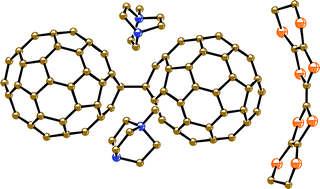Dimerization of C60˙− in multi-component ionic complexes with bis(ethylenedithio)tetrathiafulvalene: (cation+)2·ET·(C60˙−)2†
Abstract
Two multi-component ionic complexes (cation+)2·ET·(C60˙−)2 comprising C60˙−

* Corresponding authors
a
Division of Chemistry, Graduate School of Science, Kyoto University, Sakyo-ku, Japan
E-mail:
saito@kuchem.kyoto-u.ac.jp
b
Institute of Problems of Chemical Physics RAS, Moscow region, Chernogolovka, Russia
E-mail:
konarev@icp.ac.ru
c Institute of Solid State Physics RAS, Chernogolovka, Moscow region, Russia
d Research Center for Low Temperature and Materials Sciences, Kyoto University, Sakyo-ku, Japan
Two multi-component ionic complexes (cation+)2·ET·(C60˙−)2 comprising C60˙−

 Please wait while we load your content...
Something went wrong. Try again?
Please wait while we load your content...
Something went wrong. Try again?
D. V. Konarev, S. S. Khasanov, G. Saito, A. Otsuka and R. N. Lyubovskaya, J. Mater. Chem., 2007, 17, 4171 DOI: 10.1039/B704371F
To request permission to reproduce material from this article, please go to the Copyright Clearance Center request page.
If you are an author contributing to an RSC publication, you do not need to request permission provided correct acknowledgement is given.
If you are the author of this article, you do not need to request permission to reproduce figures and diagrams provided correct acknowledgement is given. If you want to reproduce the whole article in a third-party publication (excluding your thesis/dissertation for which permission is not required) please go to the Copyright Clearance Center request page.
Read more about how to correctly acknowledge RSC content.
 Fetching data from CrossRef.
Fetching data from CrossRef.
This may take some time to load.
Loading related content
